The 2017 Ford Fusion receives a few tweaks to the exterior design and some functional improvements to the interior versus last year’s model. Also, new for 2017 is the addition of the 325hp V6 engine equipped to the performance oriented Fusion Sport model.
With 12 models of the 2017 Fusion ranging from the basic S model all the way up to the performance Sport model and including the hybrid and plug in hybrid models in between, there’s a Ford Fusion that’s right for everyone!
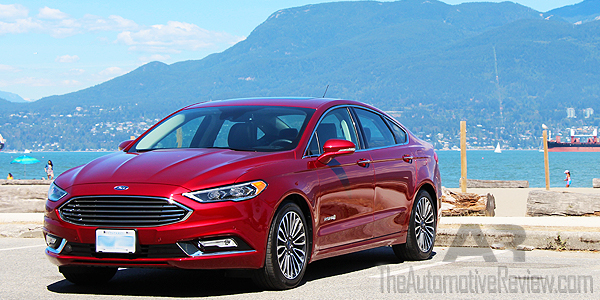
2017 Ford Fusion Hybrid Titanium Ruby Red Front Side View
Something I’ve always wanted to do was compare a hybrid to its gas engine counterpart and that’s exactly what I’m going to focus on in this review of the 2017 Ford Fusion SE versus the 2017 Ford Fusion Titanium Hybrid. Although I would have liked to compare similar quality trim levels, I will note where applicable the differences between SE and Titanium to keep the comparison as fair as possible.
GENERAL THOUGHTS – Hybrid vs. Gas
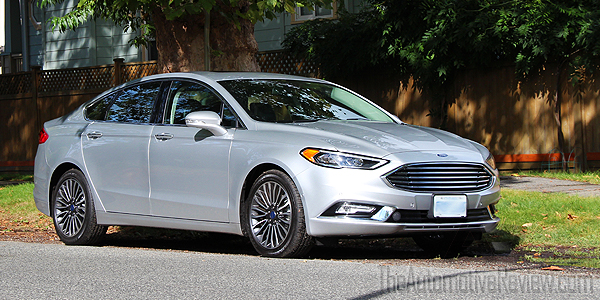
2017 Ford Fusion SE Ingot Silver Front Side View
Typical driving qualities of hybrids, especially having driven my fair share of them, include a whisper quiet drive at low speeds with the electric motor and then a noticeable jolt when the gas engine kicks on. Hybrids are also usually heavier and have less trunk space because of the battery. However, the main benefit to hybrids are the low carbon foot print they leave and the efficiency of harnessing usually wasted braking energy to recharge the battery. This all leads to a much better fuel consumption which is typically lower in the city than on the highway (opposite of gas engine vehicles), due to the additional use of the electric engine at lower speeds.
ENGINE & DRIVE
Both the 2017 Ford Fusion SE and the 2017 Ford Fusion Hybrid Titanium offer a similar driving experience despite the fact that the mechanics under the hood are vastly different. Both vehicles deliver a solid, quiet and smooth drive, despite their relatively low engine power.
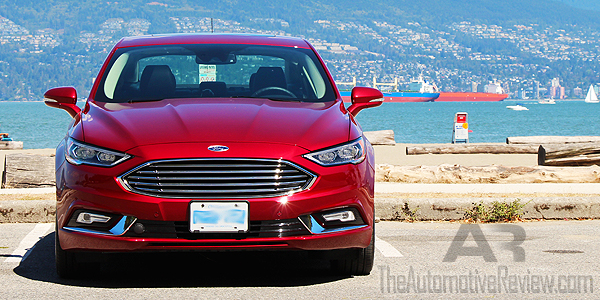
2017 Ford Fusion Hybrid Titanium Ruby Red Front View
The 2017 Fusion SE comes equipped with a 2.5L four cylinder engine, outputting 175hp and paired to a 6 speed automatic transmission, while the 2017 Fusion Hybrid pairs a 2.0L four cylinder gas engine with an electric motor to create a total of 188hp paired with a continuously variable transmission. Despite being sub 200hp engines, I was surprised how quiet and smooth the engine performed. While acceleration was a bit on the slow side, it was more than enough for daily driving, highway overtaking and driving with a full load of passengers and cargo. Both versions had great handling and cornering and the steering was aimed more towards a relaxed drive rather than a stiffer racy feel.
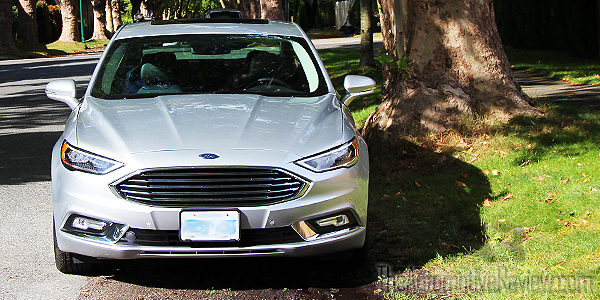
2017 Ford Fusion SE Ingot Silver Front View
Although there were many similarities in driving feel, there were also some minor differences to note. The Fusion SE had a slightly faster acceleration but the engine noise was somewhat louder than the Hybrid. Also, the SE comes equipped with an automatic engine shut off feature when stopped, and although this improves fuel efficiency, I found when the engine restarts it sounds louder and more jarring than when the hybrid’s gas engine starts up. On the other hand the Hybrid had an incredibly smooth drive, including the transitions from electric to gas, as well as a smooth feel with the braking which has been known to be clunky in most other hybrids. I found the Hybrid to be quieter than the SE even with the gas engine working, although I did notice a faint whirring sound when the gas engine kicks on.
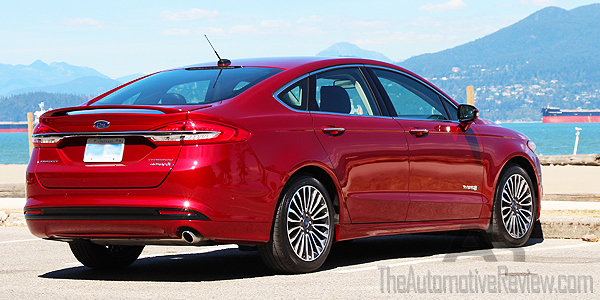
2017 Ford Fusion Hybrid Titanium Ruby Red Rear Side View
The biggest and most obvious difference resulting from the different engines is the fuel efficiency. Our 120km mostly city test drive recorded a fuel consumption of 12.4 L/100km for the Fusion SE and 5.5 L/100km for the Fusion Hybrid. This can translate into huge savings depending on the amount and type of driving you do, which I will touch on further down. A nice feature built into the Fusion Hybrid is the coaching display that teaches optimal hybrid driving in real time by displaying meters rating your performance with braking, accelerating and coasting.
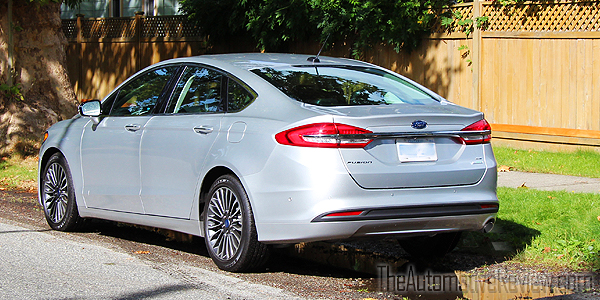
2017 Ford Fusion SE Ingot Silver Rear Side View
Both the Fusion SE and Hybrid were equipped with Ford’s Park Assist feature which always impresses drivers and passengers seeing it in action for the first time! This feature takes away the guess work of reverse and parallel parking and takes control of the steering so the driver only has to apply gas and brakes. Every time I used this feature it parked perfectly, on the first try, within inches from the curb. This is by far the best way to ensure you won’t accidentally curb your rims!
EXTERIOR & INTERIOR
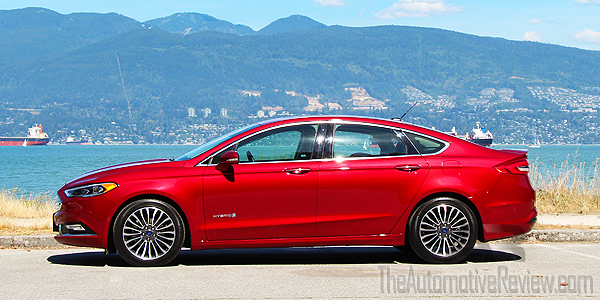
2017 Ford Fusion Hybrid Titanium Ruby Red Side View
New for the 2017 Ford Fusion exterior is a slightly updated front and rear end, improving an already attractive exterior design. The Aston Martin-like grille is slightly wider and more refined, LEDs are added to the shapelier headlights and a chrome strip bisecting the tail lights has been inserted creating a bold yet elegant look to the overall exterior design. The low and wide stance, accent lines and curves and the body shape make the Fusion one of the better looking mid size sedans available on the market.
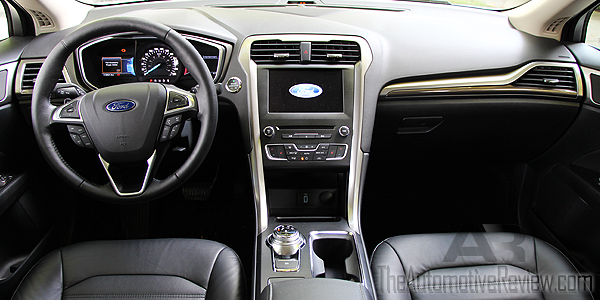
2017 Ford Fusion SE Interior Dash
Stepping into the cabin of the Fusion, you are surrounded by a well thought out interior space. A nice blend of decent quality materials, plenty of storage areas and a minimalistic dash adorn the interior of both the SE and Hybrid Titanium. There was a slightly different dash between the two models due to the addition of the Sony premium stereo and ambient lighting on the Titanium model. Of the two, I preferred the dash of the Titanium as it was cleaner, more modern and had the ambient lighting color selection available.
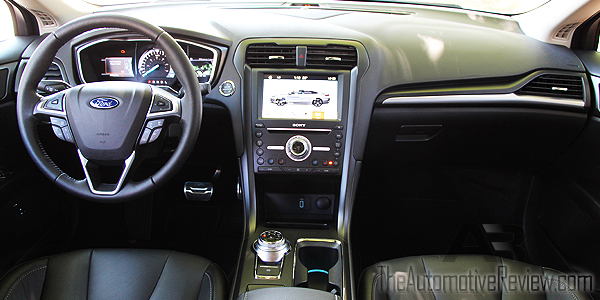
2017 Ford Fusion Titanium Interior Dash
While the Titanium model is one step up from the SE, it will therefore include features that are either optional or not available on the SE trim. Some of the features I find important that are included as standard on the Titanium but optional on the SE include dual zone automatic climate control, a reverse sensing system, leather wrapped steering wheel, premium Sony stereo system, Sync 3 interface, LED fog lights and a rear spoiler. Other features like steering wheel mounted paddle shifters and AWD are optional on the SE but not available on hybrid models. Both models were outfitted with leather seating and both were firm and comfortable, but I preferred the sportier design of the seats in the Titanium versus the more traditional design in the SE.
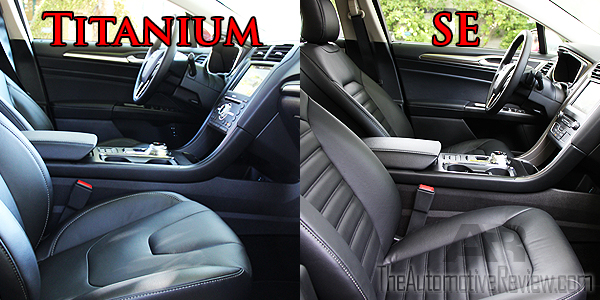
Leather Seat Comparison Titanium vs SE
An important difference to note between the SE and Hybrid models is the difference in trunk capacity. Because the electric motor battery is stored in the trunk area, the Hybrid has a much small trunk capacity of 339.8L versus the SE’s 453.1L trunk volume (33% larger).
ECONOMICS
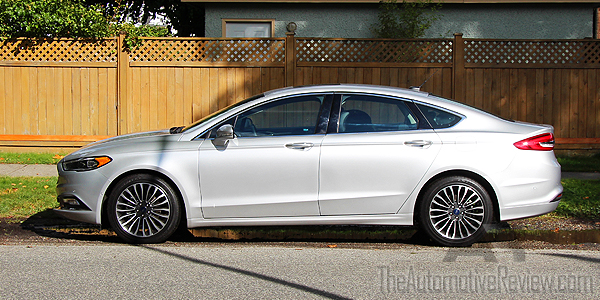
2017 Ford Fusion SE Ingot Silver Front Side View
While I have been comparing the SE to the Titanium Hybrid throughout this review, it would perhaps be more pertinent to compare the SE to the SE Hybrid for a more accurate economic analysis. The 2017 Ford Fusion SE starts at 23,698 while the 2017 Ford Fusion SE Hybrid starts at $27,293 (or $32,099 for the Titanium level).
Knowing this price difference and also the fuel consumption of each we are able to clearly analyze both the amount of savings from fuel costs as well as to calculate a time to payback the difference in price. Based on our very similar test drives, the savings in fuel consumption between the SE and the Hybrid was 6.9 L/100km (12.4 L/100km for the SE minus 5.5 L/100km for the Hybrid), while the price difference between the Fusion SE and the SE Hybrid is $3,595.
Living in British Columbia, where the gas is not cheap, we will use an average price of $1.20/L for our calculations. So, now that we know the numbers, let’s see some interesting math:
Fuel Cost Savings per 100 km = $8.28 (6.9 L/100km x $1.20/L)
Kilometers to Payback initial price difference = 43,418 km ($3,595 ÷ $8.28 x 100km)
Total Savings from Driving 100,000 km = $8,280 (100,000 km x $8.28/100km)
To put things in simple terms, because of the fuel savings, if you drive your 2017 Ford Fusion Hybrid for 43,418 km then you will have paid the same amount as if you were driving the 2017 Ford Fusion SE. With an average annual mileage of 18,000 km it will take just under 2.5 years to reach this break even point. So, if you plan on driving your Fusion further than 43,428 km (based on $1.20/L for gas) then the cheaper and smarter choice is to go with the Hybrid. It costs a little more up front but will save you money in the long run.
FINAL THOUGHTS
Thankfully Ford doesn’t compromise when it comes to safety and includes ALL safety features as standard across all models. The only option for all models is the inflatable rear seat belts. This all leads to the 2017 Ford Fusion receiving the highest safety rating from IIHS.
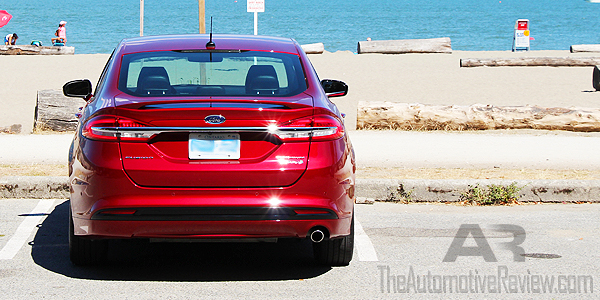
2017 Ford Fusion Hybrid Titanium Ruby Red Rear View
There’s no doubt that Ford has done a superb job in creating the 2017 Fusion and whether you choose to go with the SE or the Hybrid you will be well taken care of! After reviewing the similarities and differences between the two, only you will be able to decide which version better fits your lifestyle and budget. I will say that Ford’s pricing for upgrading to the hybrid model is a great deal and will probably pay for itself quicker than any other comparable on the market!




